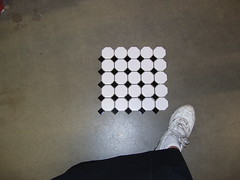Okay, I have finally dug up my Wikipedia log in info and I’m now dangerous. I thought about making changes to the Shaw, DC wiki article but the changes would be so extensive, it frightens me. For example:
Shaw once included the areas of smaller neighborhoods, such as Logan Circle and Truxton Circle, but in recent years those neighborhoods have grown into their own and become separate from Shaw.
It was the RLA and the National Capital Planning Commission that created it, who else is to say what’s in and what’s out. The Post still occasionally refers to parts of Logan as Shaw. Besides I consider myself part of Shaw. I wouldn’t know where to start with that statement.
Shaw grew out of freed slave encampments in the rural outskirts of Washington City. It was named after Civil War Colonel Robert Gould Shaw, the commander of the 54th Massachusetts Volunteer Infantry.
There were houses located in the Shaw area prior to Lincoln’s presidency and the Civil War. And then there are those pesky white people, who really don’t fit in this wonderful AfAm History narrative. I don’t doubt the Shaw in question is Col Robert G. Shaw. But the actual naming the neighborhood after him…. I’d have to wipe out the whole dang paragraph and replace with something that reads like. In 19?? (50 something 60 something) the Government agency (RLA? NCPC? Model Cities? I gotta look back and figure out who to blame) carved the Shaw School Urban Renewal Project out of the city’s 2nd District. The Shaw school, a junior high school named after Civil War commander Colonel Robert Gould Shaw, of the 54th Massachusetts Volunteer Infantry, covered an ??? square acre area running from 15/14th Street on the west, Florida Avenue (and some other little streets above FL) on the north, North Capitol Street on the east and M Street to the south. The Shaw School Urban [whatever] became what is currently called Shaw.
Shaw thrived in the late 19th and early 20th centuries as the pre-Harlem center of African-American intellectual and cultural life. Howard Theological Seminary received its first matriculates in 1866; by 1925, Professor Alain Locke was advancing the idea of “The New Negro,” and Langston Hughes was descending from Le Droit Park to hear the “sad songs” of 7th Street. The most famous Shaw native to emerge from this period—sometimes called the Black Renaissance of DC—was Duke Ellington.
The problem with establishing the neighborhood name in the mid 20th Century is referring to the cool stuff that happened before the establishment of the recognized name. Also where the heck was the Howard Theological Seminary? Yes, I could look it up, and I will, maybe around lunchtime. I’m worried about stealing another neighborhood’s history, which is a problem when certain things are close to or straddle the boarders. Also the notables need addresses that actually put them in the neighborhood, so as that we are not stealing another neighborhood’s historical figures.
Oh, and there is not a single solitary thing about the urban renewal. Can’t ignore the urban renewal. And more importantly, the why, the reason for the urban renewal in the first place.
Since as a habit, I tend to work with primary sources and not secondary sources, that makes writing a history of something probably more difficult for me than it really needs to be. Secondary sources, like books on the topic, and there is one out there, sum up what the primary sources (like newspaper articles from the day and eyewitness accounts) say.
PS- Blagden Alley people, the wiki for your area is ripe for the pickin’.
Update: As of 1/2 through my lunch dish I wandered around the net and found that Howard Divinity School was (according to the Divinity School website) in Douglass Hall, which is north of Florida Ave, was never in the Shaw School borders (and why would any part of Howard U be part of the urban renewal plan).


